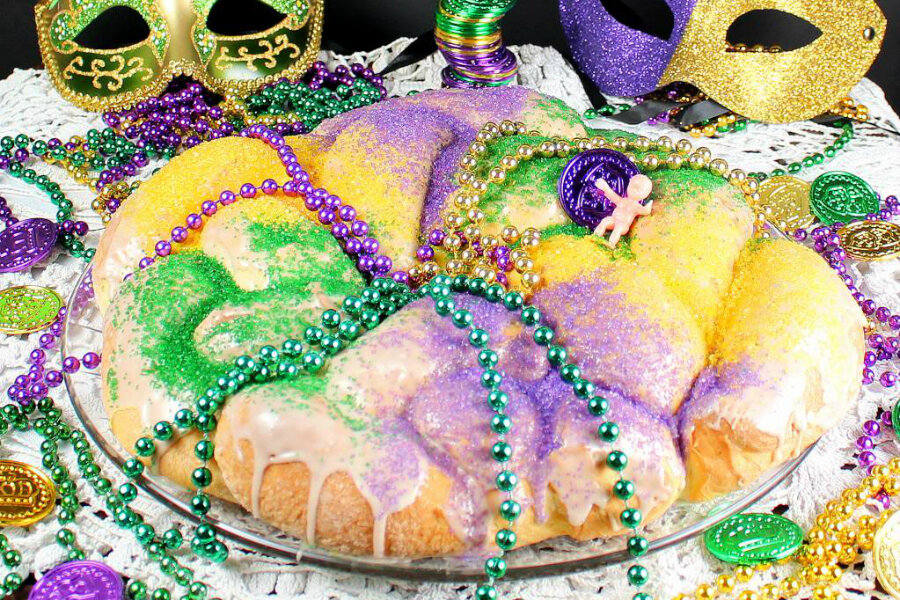King's Cake for Mardi Gras
Loading...
Although extremely popular during the season of Carnival/Mardis Gras, the King’s cake traditionally has its roots in Europe, from the Middle Ages. The cakes are eaten as part of the celebrations following Christmas on Epiphany (Twelfth Night) after the birth of Christ, and the gifts of the Magi – the three kings who offered gifts to the Messiah. Celebrations would continue from then all the way through Fat Tuesday/Mardis Gras, and the beginning of the Lenten season.
Often, a token was hidden inside the cake – a coin or bean, which is said to give the person who finds it inside their bread good fortune throughout the year. This has come to include the insertion of a plastic baby after the cake is baked, usually by tucking it inside from the bottom, where no one can see.
The cake itself is usually decorated with icings and sugars in the colors of the Mardis Gras: green, purple, and gold. These were originally selected to honor the grand Duke Alexis Romanov Alexandrovitch of Russia during his visit to New Orleans during the Mardis Gras by the master of ceremonies, Rex, the King of Carnival, and his krewe, who chose the colors as they were the colors of the Grand Dukes home. From there, the colors gained symbolic meaning, purple stood for justice, green for faith and gold for power. Those who received such beads in that color got luck in that particular area, and I imagine if they ate the portion of cake with those color sugars, they would gain favor in those colors as well.
And this is all great and fun, but we really have here is a French brioche sweet bread/pastry, which can include fillings. Sometimes it is filled with cinnamon but this recipe uses almond paste to symbolically combine forces with the bean/coin inside that may well represent the seed, or baby. But in fact it tastes great and that’s why I chose it for this recipe. It makes a great coffee cake or breakfast bread, and if you happen to prepare it out of season, instead of decorating with the usual three colors of crystal sugars, you might do well to sprinkle the icing on top with toasted sliced almonds and chopped glace cherries.
I do hope you enjoy. My husband says this tastes so good it should be illegal. It certainly tastes a far cry better than the king’s cakes you can get at the market. And no harder to make really than your average homemade bread.
King's Cake
1-1/2 pounds all purpose flour
1 tablespoon fast-rising yeast
1 teaspoon salt
1/4 cup granulated sugar
1 cup buttermilk
1/2 cup softened butter
8 ounces almond paste
1 cup confectioners/powdered sugar
1 teaspoon vanilla extract
5 teaspoons milk (approximate)
colored crystal sugars (green, gold, purple) or toasted sliced almonds and chopped glace cherries
1. Place 1 pound of the flour in the bowl of an electric mixer with the yeast, salt, and granulated sugar and gently mix.
2. Heat buttermilk until it reads between 120 degrees F to 130 degrees F on an instant read thermometer.
3. With mixer running on low, fitted with a dough hook, gently add milk and let it mix to combine.
4. Add remaining dough in small amounts at a time, continuing to mix until dough comes together and appears shaggy, or rough surfaced and a bit dry. There may be a bit of adjustment here with the dough until you hit your mark – if it is really really dry, dip your fingers and splash it with a few drops of water at a time, or if too wet, sprinkle about a tablespoon of additional flour at a time. Small adjustments are key – and so many things can affect that: temperature, humidity, protein content of flour – even the kind of buttermilk you use will change things up. Just remember that adjustments are necessary for everyone as dough making can sometimes be more art than formula occasionally. You will soon be a pro at how your dough should look if this is your first time making brioche or any home made bread.
5. Add softened butter, one tablespoon at a time, allowing dough to absorb it before adding another.
6. When all the butter is added, allow the mixer to knead the dough for about 8-10 minutes. At the end of that time, the dough should appear soft and smooth with a light sheen, kind of like a baby’s butt.
7. At this time, turn the dough out into a bowl sprayed with nonstick spray or a light coating of oil; add the dough; cover loosely with plastic wrap and refrigerate for one hour.
8. About 35 minutes into the chilling time, preheat your oven to 350 degrees F.
9. When dough has chilled for one hour, turn it out onto a lightly floured surface and roll out into a rectangle about 17″x12″ or so.
10. Using a knife or pizza cutter, cut the dough lengthwise into three strips.
11. Open the almond paste and divide it into three equal parts. Roll the paste out into a cyclindrical shape, much the way you would with modeling clay. Make each piece as long as the dough strip.
13. Place each piece of almond paste into the center of each dough strip and seal inside, pinching the edges closed completely. Take three ends of the dough strips and pinch them all together. Then braid the pieces together forming one long strip. Then gently lift the braid and bring the two ends together, pinching the dough into a ring.
14. Gently place the dough ring onto a parchment paper lined baking sheet (I lifted it with my two largest pancake turners). Spritz the top of the dough lightly with nonstick spray and loosely place a sheet or two of plastic wrap on it to cover.
15. Place dough in a warm, draft-free place for one hour to allow it to double in size. I place my baking sheet on top of a orthopedic heating pad turned on high and don’t have issues coming back and finding the room to cool- but if you do this, keep an eye on it so it doesn’t rise to much and over proof. That can cause your bread to over inflate and later collapse (over proofing).
16. Place sheet in the oven and bake for 30 minutes or until the top is golden brown.
17. Let the cake cool on the baking sheet when it is done for about ten minutes so that it doesn’t try to sink into a wire cooling rack, then finish cooling it on the parchment on a wire rack completely.
18. Whisk together the icing, adding 1 tbsp. milk at first and then only enough of the 2 remaining teaspoons of milk until you can whisk it into a drizzling consistency. Be careful, because towards the very end a small amount of milk can really affect the consistency. If it gets too runny just whisk in some more sugar.
19. Drizzle icing over cooled cake or you might like to apply it like paint with a silicone basting brush (to get into the nooks and crannies).
20. While the icing is still wet, sprinkle liberally with colored crystal sugars. Or you might opt to sprinkle it with toasted slices almonds and chopped glace cherries in the off season. Alternate colors of crystal sugars for the best appearance.
21. Slice and serve.
Related post on a Palatable Pastime: Cajun Style Crab Dip








